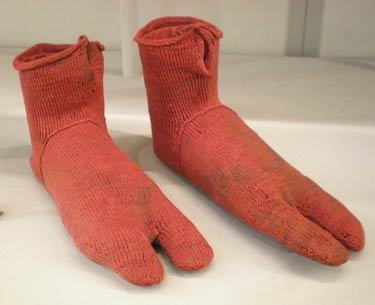Category Archive 'Egypt'
19 Oct 2018

Pharaoh Ramesses II’s Egyptian passport, issued in 1974 for passage to France nearly three millennia after his death.
In order to leave the country, Egypt required anyone leaving the country, living or dead, to have the proper papers. Seemingly the first mummy to receive one, Ramesses had his occupation listed as “King (deceased).â€
I bet the Pharoah would say that the Adninistrative State has really gotten out of control in the 3000 years since his death.
02 Mar 2018


A papyrus fragment containing text from St. Paul’s Letter to the Galatians offered for sale on eBay in 2012. Oh me, oh my!
Roberta Mazza proves that you can have a graduate degree and specialized academic expertise and still be a total imbecile with respect to markets, governments, and reality.
We academics must help protect the objects we study. Some of my colleagues believe that scholarship comes first, or say that texts have no guilt, so we should be faithful to them. They publish what emerges from the market. I disagree. To publish papyri with suspicious — if not illegal — provenance is unethical. It lends a new identity to those artefacts and feeds the illicit market.
Looting and illicit excavations in Egypt not only destroy the archaeological landscape forever, but also have also caused deaths and injuries to Egyptians, including children, employed to dig in narrow shafts. In 2016, two archaeological guards, Ashrawy and Mustafa Ali, were shot dead by looters in action. And there is good reason to believe that many crimes go unreported in the current political and economic climate. (That said, in the UK, academics who facilitate exchanges of improperly-obtained antiquities can be charged for money laundering.)
So what should we do with all of these suspiciously-sourced fragments? They should be immediately returned to the legitimate owner: Egypt. (Egyptian authorities may eventually reach a deal with the collectors for study and publication before repatriation.) Those who study papyri must exercise due diligence before publishing anything, and academics should exercise an active role in educating collectors and keeping an eye on the market. Would you knowingly buy a stolen bike? Why would you buy — or publish — a stolen manuscripts?
RTWT
Ms. Mazza, firstly, suffers from the self-entitlement and inclination-to-control-the-universe syndrome which characteristically afflicts credentialed members of the academical elite. That naturally combines with uncritical left-wing statism, producing a pathological hostility to free markets and the voluntary and organic interactions of ordinary mortal human beings who lack badges, official positions, and doctorates, along with an uncritical bias in favor of the State, even when the State consists of a corrupt Third World kleptocracy and dictatorship.
The rational reader learns from Dr. Mazza’s article that this small papyrus fragment was offered for sale on Ebay by a source one might not want to invite home to meet the parents, but in the end a little way down the road, what do you know! was evidently purchased by some capitalistic plutocrat and donated to a museum, where it is obviously being carefully preserved and kept available for study and research.
Her problem, of course, is the absence of a good provenance. But Dr. Mazza expects everything her own way, and refuses to reflect on causes and effects and the nature of reality. Why is there no provenance? Obviously a provenance is lacking, because this papyrus fragment could not be bought and sold openly. It had to travel from valueless, totally inaccessible, probably dangerous occult obscurity to its resting place in a prominent collection via the black market.
Why the black market? Obviously because greedy, pompous, grasping primitive governments like that of Egypt despotically claim total ownership of all antique, archaeological, and historically valuable material found, discovered, unearthed, or passed along in some chain of private or corporate possession in their territory. Better that artifact lie buried in the ground than that some Egyptian peasant carry on the millenia-old antiquities hunting trade, find it, profit privately, and let the item go to some institutional collection in a civilized Western country. No, no, no, that would be a theft from, and an affront to, the People’s Collectivist State.
Obviously, if in a different world, a world in which academicians looked objectively at economic reality, Human Nature, and the legitimacy, ethical qualities, and level of sophistication and culture of different governments and societies, those academics would do the really ethical thing and dismiss out of hand the insolent claims of ephemeral contemporary brigandish regimes to the inherited legacy of mankind generally, and they would insist that private initiative and market forces be permitted to operate freely, recognizing the former as by far the most efficient, effective, and reliable mechanisms, those being actually in accord with individual self interest, for the recovery and preservation of antiquities of every kind.
In a free market situation, instead of being covertly offered on Ebay, a valuable papyrus fragment would have been advertised widely with every bit of documentation and provenance possible in order to maximize the object’s value and to bring it to the attention of every possible interested individual and institutional collector. The missing provenance isn’t the fault of market processes. It is the fault of over-reaching, oppressive Statism.
21 Feb 2017


Ancient Origins:
The ancient Egyptians were renowned for their worship of animals, and one of these was the baboon. In ancient Egyptian mythology, baboons are best known for their association with Thoth, the god of wisdom. In addition to their role in mythology, baboons also had a place in the society of ancient Egypt. They are commonly known to have been kept as pets, and mummified remains of these creatures have been discovered by archaeologists. In addition, baboons (or monkeys) have also been shown in Egyptian art to be participating in various human activities, including dancing and playing musical instruments, picking fruit, making wine and beer, and even catching criminals. …
As sacred animals, baboons were kept in temples, and cared for by their priests. Nevertheless, they were also kept as pets by those who could afford them, though for largely ritualistic purposes. Still, such pets were not always treated well by their owners. In Hierakonpolis, for instance, archaeologists have discovered a cemetery with the remains of various animals, including baboons, that were once kept as pets. The bones of the baboons suggest that they had been beaten repeatedly whilst they were alive. This cemetery is about 5000 years old, and dates to the end of the Pre-Dynastic period / the beginning of the Early Dynastic period. Therefore, it has been suggested that at this point of time, the ancient Egyptians were only beginning to learn how to keep animals as pets, and the beatings were meant to keep the baboons in line. As the Egyptians became better handlers, fewer beatings were administered to their pets, as seen in the remains of baboons from later periods.
In some works of ancient Egyptian art, baboons (or monkeys) are shown engaging in human activities. Some of these, like harvesting fruits from tall trees, could be plausible. In some parts of the world, monkeys are known to be trained to harvest fruits. In a tomb from the 12th Dynasty, baboons are even shown to be competing with humans for the collection of fruit. Other baboon jobs, such as helping with alcohol production or rigging boats, seem a little more fantastical. Nevertheless, given that baboons were considered to be intelligent animals, it would not then be too surprising if the ancient Egyptians imagined baboons could do such activities.
01 May 2016

A lion devouring a Nubian, crafted during the 19th dynasty possibly as a fly-whisk handle, symbolizing the valiant ruler of Egypt subjugating the Nubians to protect his country and avert chaos. Metropolitan Museum.
Via Ratak Monodosico.
More views
25 Jun 2014


Walter Russell Mead delivers, what Andrew Sullivan calls, “a majestically sweeping indictment of everything [P]resident Obama has achieved in foreign policy over the last six years.”
One wishes we had a Republican President right now if only because when a Republican is in the White House, the media and the chattering classes believe they have a solemn moral duty to categorize and analyze the failures of American strategy and policy. Today that is far from the case; few in the mainstream press seem interested in tracing the full and ugly course of the six years of continual failure that dog the footsteps of the hapless Obama team in a region the White House claimed to understand. Nothing important has gone right for the small and tightly knit team that runs American Middle East policy. Most administrations have one failure in Israeli-Palestinian peacemaking; this administration has two, both distinctly more ignominious and damaging than average. The opening to the Middle East, once heralded by this administration as transformative, has long vanished; no one even talks about the President’s speeches in Cairo and Istanbul anymore, unless regional cynics are looking for punch lines for bitter jokes. The support for the “transition to democracy†in Egypt ended on as humiliating a note as the “red line†kerfuffle in Syria. The spectacular example of advancing human rights by leading from behind in Libya led to an unmitigated disaster from which not only Libya but much of north and west Africa still suffers today.
Rarely has an administration so trumpeted its superior wisdom and strategic smarts; rarely has any American administration experienced so much ignominious failure, or had its ignorance and miscalculation so brutally exposed. No one, ever, will call this administration’s Middle East policies to date either competent or wise—though the usual press acolytes will continue to do what they can to spread a forgiving haze over the strategic collapse of everything this White House has attempted, as they talk about George W. Bush at every chance they get.
Now, from the ruins of the Obama Administration’s Middle East strategy, the most powerful and dangerous group of religious fanatics in modern history has emerged in the heart of the Middle East. The rise of ISIS is a strategic defeat of the first magnitude for the United States and its allies (as well as countries like Russia and even China). It is a perfect storm of bad policy intersecting with troubled times to create the gravest threat to U.S. and world stability since the end of the Cold War.
The mainstream press and the professional chatterboxes of the news shows need to set aside their squeamishness at poring over the details of a major strategic failure by a liberal Democrat. The rise of ISIS/ISIL is a disaster that must be examined and understood. How could the U.S. government have been caught napping by the rise of a new and hostile power in a region of vital concern? What warning signs were missed, what opportunities were lost—and why? What role did the administration’s trademark dithering and hairsplitting over aid to ISIS’s rivals in the Syrian opposition play in the rise of the radicals?
Read the whole thing.
14 Dec 2013


UK Independent, News > Environment, Charles Onians, Monday 20 March 2000:
Snowfalls are now just a thing of the past
Britain’s winter ends tomorrow with further indications of a striking environmental change: snow is starting to disappear from our lives.
Sledges, snowmen, snowballs and the excitement of waking to find that the stuff has settled outside are all a rapidly diminishing part of Britain’s culture, as warmer winters – which scientists are attributing to global climate change – produce not only fewer white Christmases, but fewer white Januaries and Februaries.
The first two months of 2000 were virtually free of significant snowfall in much of lowland Britain, and December brought only moderate snowfall in the South-east. It is the continuation of a trend that has been increasingly visible in the past 15 years: in the south of England, for instance, from 1970 to 1995 snow and sleet fell for an average of 3.7 days, while from 1988 to 1995 the average was 0.7 days. London’s last substantial snowfall was in February 1991.
Global warming, the heating of the atmosphere by increased amounts of industrial gases, is now accepted as a reality by the international community. Average temperatures in Britain were nearly 0.6°C higher in the Nineties than in 1960-90, and it is estimated that they will increase by 0.2C every decade over the coming century. Eight of the 10 hottest years on record occurred in the Nineties.
However, the warming is so far manifesting itself more in winters which are less cold than in much hotter summers. According to Dr David Viner, a senior research scientist at the climatic research unit (CRU) of the University of East Anglia,within a few years winter snowfall will become “a very rare and exciting event”.
“Children just aren’t going to know what snow is,” he said.
04 Nov 2013

Tuthankamun’s mummy caught fire in his casket after embalming.
Scientists haven’t confirmed the reality of the mummy’s curse, but they have got new information of Tutankhamun’s death (of injuries inflicted by a high-speed chariot crash), and they have additionally concluded that a poor job of embalming caused the pharaoh’s mummy to catch fire via spontaneous combustion.
Daily Mail.
03 Oct 2013

Bronze flute. Egyptian, Ptolemaic period. Inscribed near the mouthpiece with: “The [divine] Nubian one and the gods of the resting place of the ibis to Thoteus son of Nekhtmonth.â€
35.9 cm length x 1.6 cm diameter.
(Source: British Museum)
Hat tip to Ratak Mondosico.
18 Aug 2013


Richard Fernandez is worried that Putin might grab Egypt while Barack Obama bicycles and golfs on Martha’s Vinyard and his administration dithers over the decision to support secularism and the Egyptian Army or radical Islam, democracy, and the Muslim Brotherhood. Decisions, decisions.
So Obama remains hunkered down in Martha’s Vineyard, emerging periodically from his vacation home, like a cuckoo from a clock, to make a statement no one appears to hear, playing for time. No one in the Beltway seems to know what line to take. Shall they restore democracy in Egypt by supporting the Muslims Bros, knowing they too will take their revenge on the generals and the Copts? Suspend aid to the Egyptian military and open the door to Russia, who might do a hat trick and scoop up Saudi Arabia into the bargain?
Choices. Choices. What happened to the good old days when one could vote “present� The Beltway is reading the tea leaves for a sign. And all they’re getting is Jay Carney.
I’m not worried. Frankly, I think Putin would do a much better job.
06 Apr 2013


Knitted socks, made 250-420 AD, found at Oxyrhynchus, donated to the Victoria and Albert Museum in 1900
Smithsonian quotes the V&A description then comments:
The Romano-Egyptian socks were excavated in the burial grounds of ancient Oxyrhynchus, a Greek colony on the Nile in central Egypt at the end of the 19th century. They were given to the Museum in 1900 by Robert Taylor Esq., ‘Kytes,’ Watford. He was executor of the estate of the late Major Myers and these items were selected among others from a list of textiles as ‘a large number of very useful examples.’
Particularly intriguing about these “very useful examples†is the technique used to construct these red wool socks. Called nÃ¥lbindning, or single-needle knitting, this time-consuming process required only a single thread. The technique was frequently used for close-fitting garments for the head, feet and hands because of its elastic qualities. Primarily from prehistoric times, nÃ¥lbindning came before the two-needle knitting that’s standard today; each needle was crafted from wood or bone that was “flat, blunt and between 6-10 cm long, relatively large-eyed at one end or the eye is near the middle.â€
We don’t know for sure whether these socks were for everyday use, worn with a pair of sandals to do the ancient Egyptian equivalent of running errands or heading to work—or if they were used as ceremonial offerings to the dead (they were found by burial grounds, after all).
For sandals? They look to me to have been made for someone (the ibis-headed god Thoth?) who had feet like a stork.


Feeds
|















